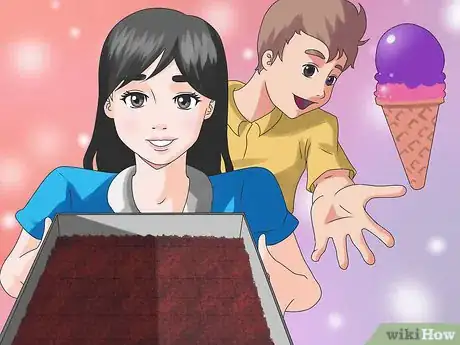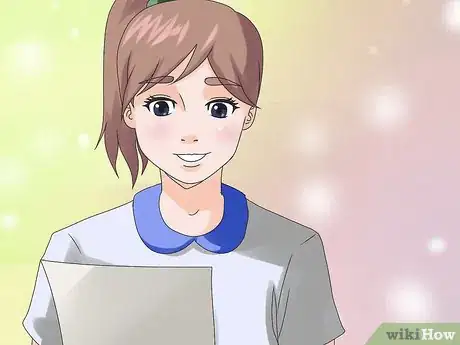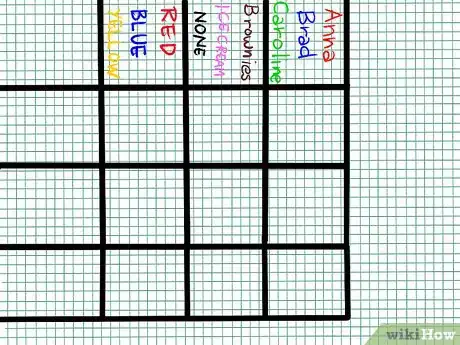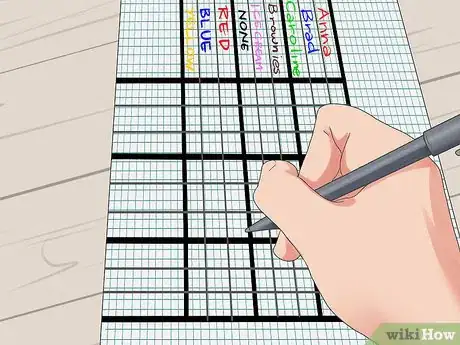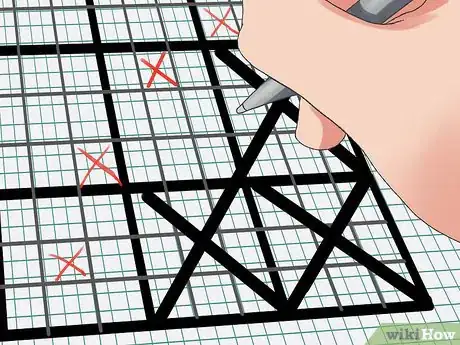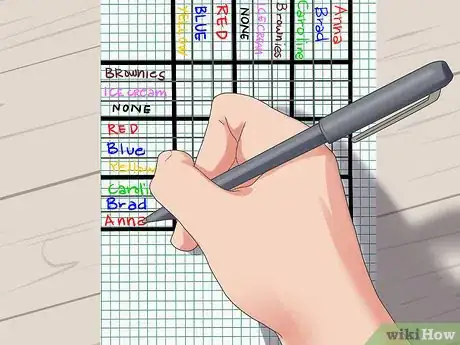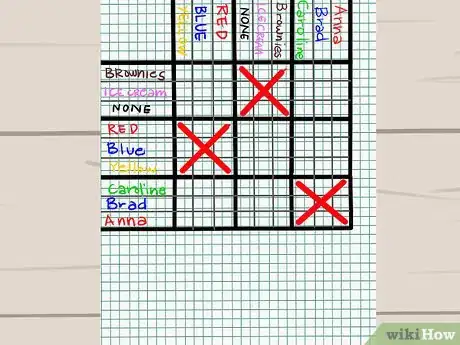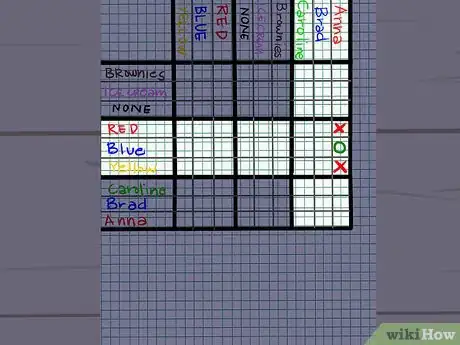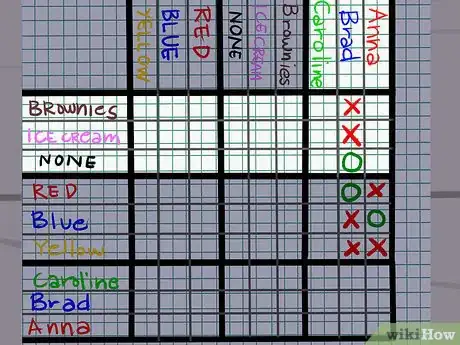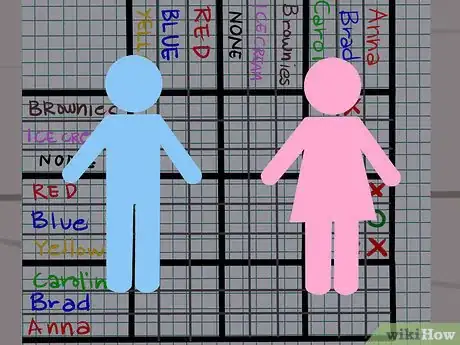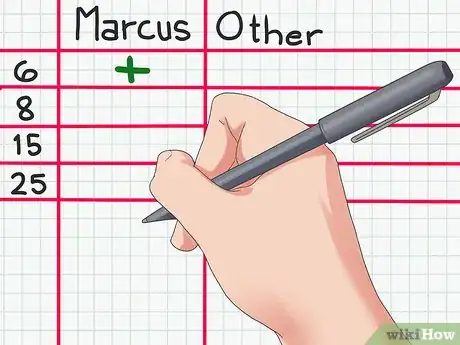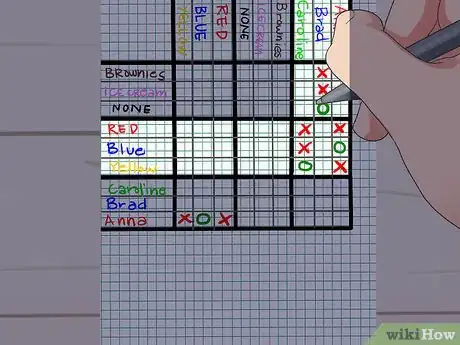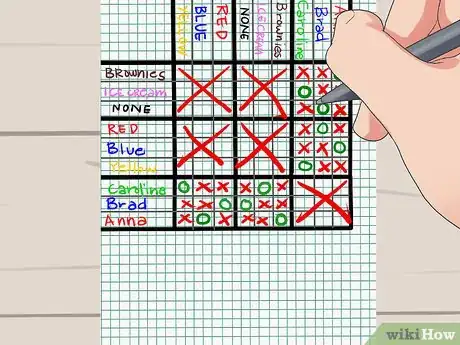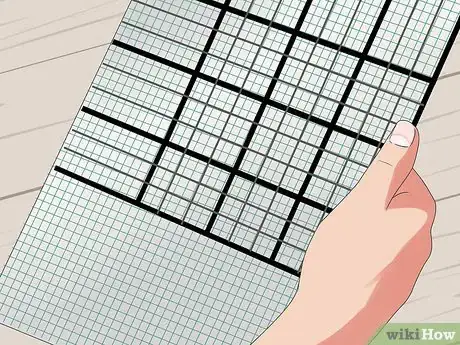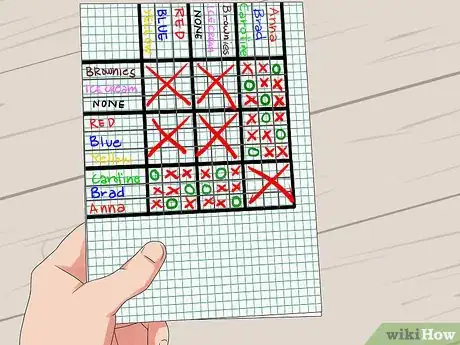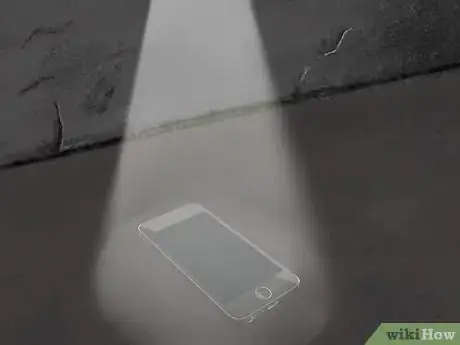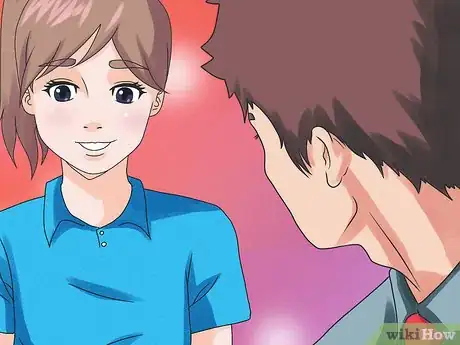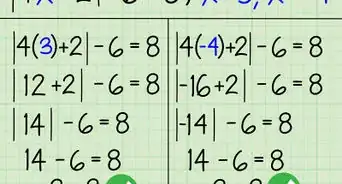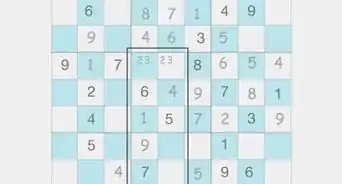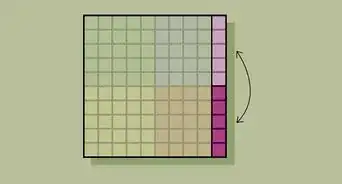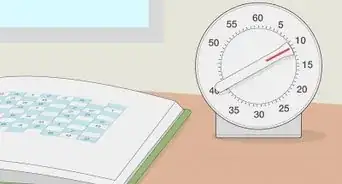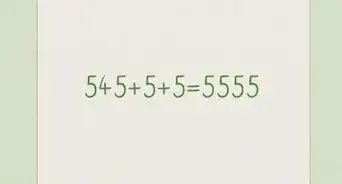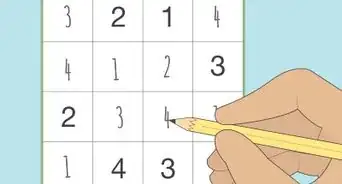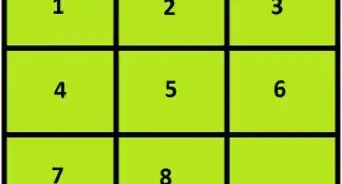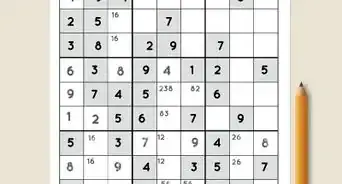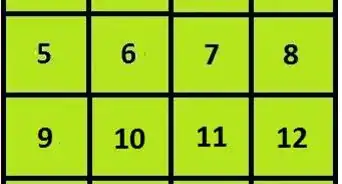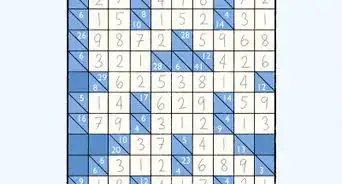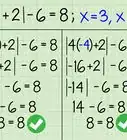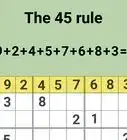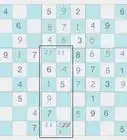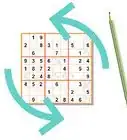wikiHow is a “wiki,” similar to Wikipedia, which means that many of our articles are co-written by multiple authors. To create this article, 17 people, some anonymous, worked to edit and improve it over time.
This article has been viewed 278,944 times.
Learn more...
This article includes general advice for logical reasoning problems, as well as thorough instructions for solving the most common type of logic puzzle. This type of puzzle provides a list or paragraph of clues, then asks you a question that requires you to use the clues to answer. Many books and websites that contain these logic puzzles come with a grid to help you solve them, but this article also includes instructions for making your own.
Steps
Setting up a Grid
-
1Use this method for logic problems that ask you to match multiple categories together. Typically, these have a description or a list of facts that describes a group of people, or houses, or other objects. The question usually has to do with matching two categories together, or listing the order a group is placed in. Many books and websites that contain collections of logic puzzles use this type of puzzle.
- Here's an example problem: Three friends named Anna, Brad, and Caroline agree to bring one dessert each to a birthday party. Each friend is wearing a different color shirt. Anna wears a blue shirt. The person who brought brownies couldn't find her red shirt today. Brad didn't bring any dessert at all, which made the person wearing a yellow shirt irritated. Which person brought the ice cream?
- The example question, like all logic puzzles of this type, asks you to match two categories together. You start out knowing the names of several people and the names of several desserts, but you don't know who brought which dessert. Using the clues in the description, you need to figure out how to match each person to a dessert until you know who brought the ice cream. There's actually a third category, shirt color, which should help you get to your answer.
- Note: skip to Using a Grid if the puzzle already comes with a grid set up. Skip to Solving Other Logic Puzzles if your puzzle does not fit this description.
-
2Read the puzzle carefully and make a list of basic information. Sometimes, the puzzle will already give you a list of names, colors, or whatever other basic information makes up the puzzle. Often, you'll have to read the puzzle carefully and make several lists yourself. Keep an eye out for the word "each": that often tells you which categories are important. For instance, "each person brought a different dessert" tells you that you need a list of people and a list of desserts.
- Write each list separately. When the puzzle mentions a name, add it to a list of names. When the puzzle mentions a color, add it to a separate list of colors.
- Each list should have the same number of items once you've finished. If a list is too short, reread the puzzle carefully for more items.
- Some tricky puzzles will give you hints about what someone doesn't have, such as "Brad didn't make a dessert." In this case, you should add "none" to the list of desserts, which should make it the same length as the other lists.
Advertisement -
3On graph paper, make a list of every item you wrote down. Write a vertical column on the left hand side of the paper, with every item you wrote down on a list on a separate line. Keep each list together and separate them with a thick line.
- For instance, let's say you have three lists. Names: Anna, Brad, Caroline; Desserts: brownies, ice cream, none; and Color of Shirts: red; blue, yellow. Write a vertical list in this order: Anna; Brad; Caroline; (draw a thick line here); brownies; ice cream; none; (draw a thick line here); red; blue; yellow.
-
4Write the lists again across the top. Write the lists again across the top of the page, in a horizontal line this time. Keep them in the same order, and separate lists with thick lines as before. In our example, write Anna; Brad; Caroline; (thick line here); brownies; ice cream; none; (thick line here); red; blue; yellow across the top.
- Once you're more familiar with this system, you can get away with not writing every list in both places. We will be using this grid to match items in the vertical list (on the left) to items in the horizontal list (at the top), and sometimes you don't need to match every item. If you've never used this method before, stick with these instructions
-
5Make a grid. Add pen or pencil lines to your graph paper so the grid is clear. Each word on the left should have a row to itself, and each word on the top should have a column to itself. Make the thick lines dividing lists extend all the way across the grid, keeping them much thicker and more noticeable than the other lines.
-
6Cross out sections of the grid you don't need. The thick lines between lists should divide your grid into several sections (nine in our example). Each section is a comparison of one list on the left and one list on the top. Follow these instructions to cross off sections you don't need, either using a large X or by scribbling over it. Be careful not to cross the thick lines into another section.
- If the list to the left of a section and the list above a section are the same, cross it out. You'll never need to compare the list "Anna, Brad, Caroline" to the list "Anna, Brad, Caroline" – you already know that Anna is Anna.
- Cross out duplicate sections. For instance, the section that compares "Anna, Brad, Caroline" on the left and "red, blue yellow" on the top is the same as the section that compares "red, blue, yellow" on the left and "Anna, Brad, Caroline" on the top. Cross off one of these duplicate sections so you only have one to pay attention to. It doesn't matter which you cross off.
-
7Move on to the next part to solve your puzzle. Now that you have the grid set up, you can use it to solve your puzzle. The basic idea is to use the clues in the puzzle to rule out certain combinations by placing an "X" or other mark in the square of the grid that represents that combination. See the next part for more information.
Using a Grid to Solve a Logic Puzzle
-
1Reread the puzzle's introduction to learn what you need to know. Keep in mind what you're trying to solve for before you begin. If you forget what you're looking for, you could get carried away and keep solving additional parts of the puzzle after you've already found the solution.
- Occasionally, a puzzle cannot be fully solved, meaning you won't be able to fill the entire grid. You should still be able to answer the question it asks.
-
2Use the grid to note down a straightforward clue. Start with one of the easiest clues, that gives you a simple fact matching two pieces of information together. For instance, "Anna is wearing a blue shirt." Find the row of your grid labeled "Anna", and follow it until you get to a square underneath the column labeled "blue". Make a circle in this square to show that Anna and the blue shirt are connected.
- If you can't find that square, search the other way around. For instance, find the row labeled "blue" and the column labeled "Anna", instead of the other way around.
- Don't start with a clue that tells you something that doesn't apply, such as "Anna doesn't wear a red shirt." While that's a useful clue that should be marked with an "X", this method will assume you started with a clue that gives positive information.
-
3Only in the immediate section, cross off the rest of that row and column. Your grid should be divided into sections by thick lines that separate the contents of one list (such as names) from another list (such as colors). Next to the square you just circled, use X marks to cross off the other squares in that row and column. Do not cross the border to another section.
- In our example, the section that has the clue you just circled compares the names of people to the colors of their shirts. The squares we're crossing off are the combinations we've ruled out, which include Brad or Caroline wearing a blue shirt, and Anna wearing a red or yellow shirt. (Typically, the introduction will tell you that each item can only be matched to one item in each other category.)
-
4Fill out the remaining simple clues the same way. If the puzzle gives you any more straightforward pieces of information that pair two items together, find the square that connects them and put a circle in it as described above. Cross off any other squares in the same row or column, but only within that section of your grid.
- If your puzzle gives you clues about what doesn't match, such as "Anna doesn't wear a red shirt", you should put an X in that column. However, since you haven't found a positive match, you should not cross out any other squares.
-
5Whenever a section has only one square left in a row or column, circle it. Let's say you continue to fill out clues until you've learned (using X marks) that Brad is not wearing a blue or yellow shirt. If there is only one other square in that row and inside that section, that square is the only possibility left. In our example, you should circle the square that shows Brad is wearing a red shirt. Remember to cross off any other squares in that column or row.
-
6Look for clues that contain hidden extra information. Some clues mention items in three or more categories. For instance: "Brad didn't bring any dessert at all, which made the person wearing a yellow shirt irritated." There are actually two clues hidden inside this sentence:[1]
- Brad did not bring a dessert. Put a circle in the Brad-none square.
- The person wearing a yellow shirt is not Brad. Put an X in the Brad-yellow square.
-
7Keep an eye out for subtle gender clues. Pronouns such as "he" or "she" are easily overlooked, but the puzzle maker may be giving you an additional clue.[2] Assume that typically male names belong to men, and that typically female names belong to women. If the clue says "The person who brought brownies couldn't find her red shirt today." then you know the person who brought brownies is female, and you should assume for the sake of a puzzle that they have a typical female name.
- If you're solving a puzzle from another country, look up the names to find out whether they are male or female. Puzzle books that are printed more than 20 years ago will sometimes contain names that were once female, but have now become male (or vice versa).
-
8Look for the words "before" and "after". Sometimes a puzzle involves days of the week, houses in a row, or some other list with a particular order. These will often have clues such as "The green house comes before the black house." This may seem useless if you don't know where the black house is, but there are actually two clues in this sentence by itself:
- The green house comes before another house, so it can't be the last one.
- The black house comes after another house, so it can't be the first one.
-
9Carefully puzzle out clues involving time. The puzzle can get trickier if one of your lists is the amount of time someone takes. For instance, perhaps you know that a group of people raced a mile and finished in 6, 8, 15, and 25 minutes. If you have a clue like "Marcus finished more than 5 minutes after the person ahead of him," you will have to consider each time and think about whether it makes sense. Here's how to work out this example:
- Marcus can't be the one who ran the mile in 6 minutes, no one was ahead of him. Cross out the Marcus-6 square.
- Marcus can't be the one who ran in 8 minutes, because that time is less than 5 minutes behind the one before it. Cross out the Marcus-8 square.
- Either the 15 or 25 minute times would work for this clue. You'll have to wait until more squares are crossed off before you can figure out which time was Marcus's.
-
10Once you've gone through all the clues, fill out more of your chart with the information you have. By now, you've probably discovered several pairings, and you can use each one to fill our more of your chart. Here's an example, going back to our original problem without anything involving time or numbers:
- Let's say you've discovered that Caroline wears a yellow shirt. Check the yellow shirt column or row for information in other sections.
- Let's say you notice on your chart that the person with a yellow shirt did not bring ice cream. Because you know that person is Caroline, you can also cross out the square that connects Caroline and ice cream.
- Check Caroline's row or column too and transfer information the same way to the yellow shirt column or row.
-
11If you're stuck, reread all the clues carefully. Many puzzle writers try to trick you, and there may be clues that you don't notice until you've read them several times. Sometimes, writing them out yourself on index cards and shifting the order can help you look at them in a different light. A friend who hasn't been working on the puzzle might see something you didn't notice.
-
12Check your grid for gaps. Remember to check your grid every so often to make sure you filled out all the squares you can. If a section has a row or column with every square crossed off except one, put a circle in that empty square. Whenever a square has a circle in it, you can cross off every other square in that section that lines up in the same row or column.
- If a row or column within a section has every square crossed off, or more than one square with a circle in it, there was probably a mistake made along the way and you may need to start over.
-
13If you're still stuck, copy the grid or switch to a different color and make a guess. Switch to a different color ink, or if you're solving a puzzle online, print it out and work on the copy. Make one guess by putting a circle or an X in an empty square.[3] Be sure to write down this guess so you will remember it. Make a guess that will let you cross off or circle additional squares. This will usually lead to a chain reaction, and either solve the puzzle or end up with an inconsistency, such as "Brad wears a red shirt and Brad wears a blue shirt".
- If an inconsistency occurs, your guess must have been wrong. Go back to what the chart looked like before you made your guess, and make the opposite one. Always keep track of when you made your guess with a new copy or a different color ink so it's easy to reverse if the guess was wrong.
-
14Check your answer with each clue. Once you've answered the question the puzzle posed, look at the clues and see if your chart makes sense with each one. It should only take a few minutes to check each answer and notice any mistakes. Unfortunately, if there is a mistake, you'll probably need to begin again, since it is difficult to backtrack with this kind of puzzle. Otherwise, congratulations! You've solved the puzzle.
- If you got the answer without filling out your entire chart, you may not be able to check every clue. As long as your chart doesn't contradict the clues you can check, you are probably correct.
Answering Logical Reasoning Problems
-
1Consider each word in the question for hidden easy answers. Many logic problems try to distract you or lead you down the wrong path. Don't follow the first train of thought that enters your head; look at each word and see if there's a simple answer that's easy to miss.
- For example: "A cell phone has fallen down a one foot (30cm) hole. How do you retrieve it? You have a wheel of cheese, three chicken feathers, and a flute." The question is designed to get you thinking about how to use bizarre objects in a creative way, but consider each word and you'll notice the hole is shallow enough to reach down and pick up the cell phone.
-
2Consider the question again before answering. Some questions will fool you by appearing too easy, when they're actually more complicated than they seem. You can avoid most of these trick questions by pausing and thinking the problem through before you make a snap decision.
- For instance, "A wind is blowing from the east, but you are facing the south side of a tree. Which way are the leaves blowing?" If you don't stop to think, you might have heard "east wind" and automatically answer "east". However, the wind is blowing from the east, so the leaves are actually blowing west.
-
3For multiple choice logical reasoning questions, consider each option in turn. Many logical reasoning test questions provide you with a list of statements and ask you what you can deduce from them, usually with multiple choice answers to choose from.[4] If the answer is not obvious to you, take the time to go through each option in turn and weight it against each statement. If one answer contradicts a statement, or you can't see how to deduce that answer from that given information, cross that answer off.
- For timed tests, if you cannot narrow it down to exactly one answer (or however many the instructions request), you may need to take a guess and move on. Make a note on your notepaper to go back to that question at the end if you have time.
-
4Take practice tests if you are preparing for an exam. If you are preparing for the logical reasoning section of an exam, find a practice booklet or take practice tests online. This is the best way to prepare, since you will become familiar with the exact type of logic problems they use.
- There are many practice tests available online for free for any major standardized school exam. If you can't find your exact exam, search for practice logic tests that match your education level.
-
5If you're at a job interview, realize that they want to hear your reasoning. If you are asked a strange logic question or out-of-the-blue question at a job interview, the interviewer is not looking for the "right answer". He or she is giving you an opportunity to demonstrate your reasoning ability. Explain every step of your logic, and feel free to give multiple answers or assume extra information as long as you make every detail clear to your interviewer. A complicated answer that takes into account several possibilities will look better than a short, correct answer that doesn't show any logical reasoning ability.
- If the question doesn't give you enough information, make an assumption or estimate and state it clearly. For instance, say "Let's say the skyscraper is 100 stories tall and has 20 windows on each story" or "First, I'll assume everyone is following the speed limit, and then I'll consider what changes if some people are traveling faster."
Community Q&A
-
QuestionHow do I solve this: You borrowed 50k from your mum and 50k from your dad to buy a laptop worth 97k. You're left with 3k, you gave your mum 1k, your dad 1k and 1k to yourself. How much do you now owe your mum?
 DonaganTop AnswererYou owe her 49k (plus interest, if any).
DonaganTop AnswererYou owe her 49k (plus interest, if any).
Things You'll Need
- Graph paper
- Pencil
- Eraser
References
- ↑ http://www.oocities.org/heartland/plains/4484/lptips.htm
- ↑ http://www.oocities.org/heartland/plains/4484/lptips.htm
- ↑ http://www.oocities.org/heartland/plains/4484/lptips.htm
- ↑ http://www.psychometricinstitute.com.au/Psychometric-Guide/Logical-Reasoning-test.html
- ↑ http://www.oocities.org/heartland/plains/4484/lptips.htm
About This Article
To solve logic puzzles, start by rewriting the question to eliminate any unnecessary or nonsensical information. Then, make a list of important clues, such as colors, names, and words that indicate a particular order, like “before” and “after.” If the puzzle is a multiple choice question, check each answer to see if it contradicts something in the question, or if the answer can’t be deduced from the given information. Afterwards, if you’re still stuck, reread the puzzle to see if you’ve missed any clues. To learn more, including how to solve logic puzzles using a grid, scroll down.
